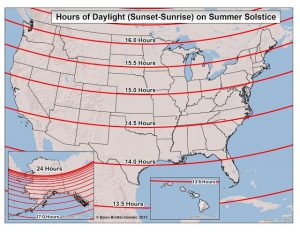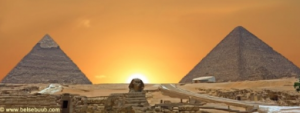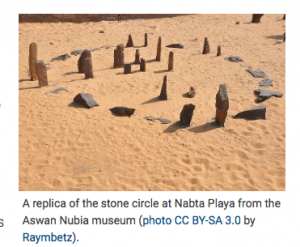
Our Earth doesn’t sit straight; it tilts. And as we travel on our planet around the Sun–at 18 1/2 miles per second–the tilt provides our seasons. Here in our Northern Hemisphere the longest, if not the warmest, day of the year will occur next Tuesday in my time zone. The Southern Hemisphere will be deep in its winter, experiencing its shortest day next week.
shortest day next week.
In our culture this longest day of the year gets a passing mention, but in the past, the Summer Solstice has been widely revered. According to The Old Farmer’s Almanac “the seasonal movement of the Sun’s path (as seen from Earth) momentarily comes to a stop before reversing direction.” link This seems pretty fanciful to me but in Latin, sol means sun and sistere means to stand still; apparently this is not a new idea. Next Tuesday at 11:24pm I intend to be outside and see if I can sense this momentous shift. (The Almanac publishes the exact time of the solstice for all time zones.)
The shift from longer days to shorter days was studied and celebrated by Druids who built Stonehenge about 5000 years ago. The sun rises directly above the Heel Stone on the day of the Summer Solstice. link Among other things, the Druids wanted to measure  time. An accurate calendar is a wonderful thing, apparently well worth moving 25 ton stones by hand for miles across the English countryside. I have written previously of the challenges of making a calendar; ours is so inaccurate that we have to add a day every four years to keep it aligned with celestial rotations. link
time. An accurate calendar is a wonderful thing, apparently well worth moving 25 ton stones by hand for miles across the English countryside. I have written previously of the challenges of making a calendar; ours is so inaccurate that we have to add a day every four years to keep it aligned with celestial rotations. link
The timing of the Summer Solstice was carefully recorded in ancient Egypt. They, too, struggled with the calendar year and added extra days periodically. The rising of the star Sirius, the Nile flood and the Summer Solstice roughly coincide and 4000 years ago, these serious people wanted to honor these events that made their lives comfortable, but they also wanted to create a reliable calendar. Some theorists believe the pyramids were placed so that solstice sun rose between the great structures. link In any case, the Summer Solstice seems to unite spiritual excellence and technical excellence.
Some theorists believe the pyramids were placed so that solstice sun rose between the great structures. link In any case, the Summer Solstice seems to unite spiritual excellence and technical excellence.
And also, perhaps, the excellence of stonework, including the moving of gigantic stones by humans. Older even than the pyramids or Stonehenge is a monument in the Nubian desert that was built perhaps 6500 years ago. Scientists believe Nabta was built by nomadic cattle-herders. Imagine cattle-herders laying 10 slabs of rock, nine feet high. Nine burial sites were created for cows each under 40 or 50 rocks that ea ch weigh 200 to 300 pounds. The technocrats of the time included a “calendar circle” of stones which corresponded to the zenith sun during the summer solstice. link
ch weigh 200 to 300 pounds. The technocrats of the time included a “calendar circle” of stones which corresponded to the zenith sun during the summer solstice. link
On the other hand, the Summer Solstice has always been a time for the celebration of plenty of light and plenty of food. It is a time of joy and security. I have room only for a few examples: in ancient Gaul, they feasted and celebrated a mare goddess; in Germany, Russia and much of central Asia, bonfires were used to honor the day; Native Americans held ritual dances and painted themselves to colors of the sky; ancient Greek feasts often celebrated the god of agriculture, Cronus, and the Summer Solstice marked a 30 day countdown to the Olympic games. link
Plants recognize the Summer Solstice as well. Plants are not foolish enough to rely on the unreliability of air temperature. The survival of plants is based on differentiating a warm spring day from the reality that winter might not be at an end. Evolution produced plants that use day length to trigger setting seed or the storage of food– the scientific name is Photoperiodism. link
The thread of day length joins us all, plants, ancient and modern humans. It is a turning point that is experienced by the entirety of our world. Perhaps there is a full stop when the days stop getting longer and start getting shorter. Winter is coming.